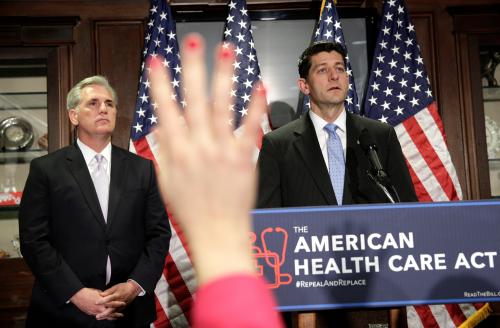This analysis is part of The Leonard D. Schaeffer Initiative for Innovation in Health Policy, which is a partnership between the Center for Health Policy at Brookings and the USC Schaeffer Center for Health Policy & Economics. The Initiative aims to inform the national health care debate with rigorous, evidence-based analysis leading to practical recommendations using the collaborative strengths of USC and Brookings.
Since the Affordable Care Act’s (ACA) health insurance marketplaces first took effect in 2014, news story after story has focused on premium increases for certain plans, in certain cities, or for certain individuals. Based on preliminary reports, premiums now appear set to rise by a substantial amount in 2017.
What these individual data points miss, however, is that average premiums in the individual market actually dropped significantly upon implementation of the ACA, according to our new analysis, even while consumers got better coverage. In other words, people are getting more for less under the ACA.
Covered California, that state’s marketplace, just announced premium increases averaging 13.2 percent. But even if premiums increase by the 10 or 15 percent overall that some are predicting for 2017, they will still be far lower than premiums otherwise would have been in the absence of the law. Moreover, this analysis does not include the effects of premium and cost-sharing subsidies that serve to make ACA marketplace plans more affordable for many people.
2014 Premiums In the ACA Marketplaces Were 10-21 Percent Lower Than 2013 Individual Market Premiums
While many stories of pronounced increases are simply the natural result of a law that works differently in every region and for people of different health statuses, it appears to be conventional wisdom that the ACA increased premiums in the individual, non-group insurance market, if only because it increased the quality and robustness of coverage. Indeed, many of the ACA’s new rules do have the anticipated effect of increasing premiums, such as:
- mandated guaranteed issue regardless of health status;
- restrictions on the ability to charge different premiums based on anything besides age and smoking habits;
- requirements for plans to offer certain benefits deemed “essential;”
- limits on out-of-pocket costs an enrollee can pay for covered services in a given year; and
- the elimination of any lifetime limits on coverage.
However, many features of the ACA push in the opposite direction and save consumers money. The individual mandate and federal subsidies greatly expanded the number of people purchasing coverage in the individual market, pushing premiums down both by increasing the sheer size of the market – the bigger the market, the lower the prices – and including many healthier people who previously went uninsured. In addition, the ACA created relatively transparent marketplaces where insurers must compete on premiums for products standardized by actuarial value, allowing competition to drive down prices.
Together, by creating a much larger and more competitive market, these changes placed strong downward pressure on insurance premiums, outweighing the factors pushing in the opposite direction. Stronger rate review and minimum requirements for how much an insurance plan must spend on actual health care expenses furthered this downward pressure on prices.
According to our analysis, average premiums for the second-lowest cost silver-level (SLS) marketplace plan in 2014, which serves as a benchmark for ACA subsidies, were between 10 and 21 percent lower than average individual market premiums in 2013, before the ACA, even while providing enrollees with significantly richer coverage and a broader set of benefits. Silver-level ACA plans cover roughly 17 percent more of an enrollee’s health expenses than pre-ACA plans did, on average. In essence, then, consumers received more coverage at a lower price.
Download “Affordable Care Act Premiums are Lower Than You Think” »
Editor’s note: This piece originally appeared in Health Affairs.
The Brookings Institution is committed to quality, independence, and impact.
We are supported by a diverse array of funders. In line with our values and policies, each Brookings publication represents the sole views of its author(s).











